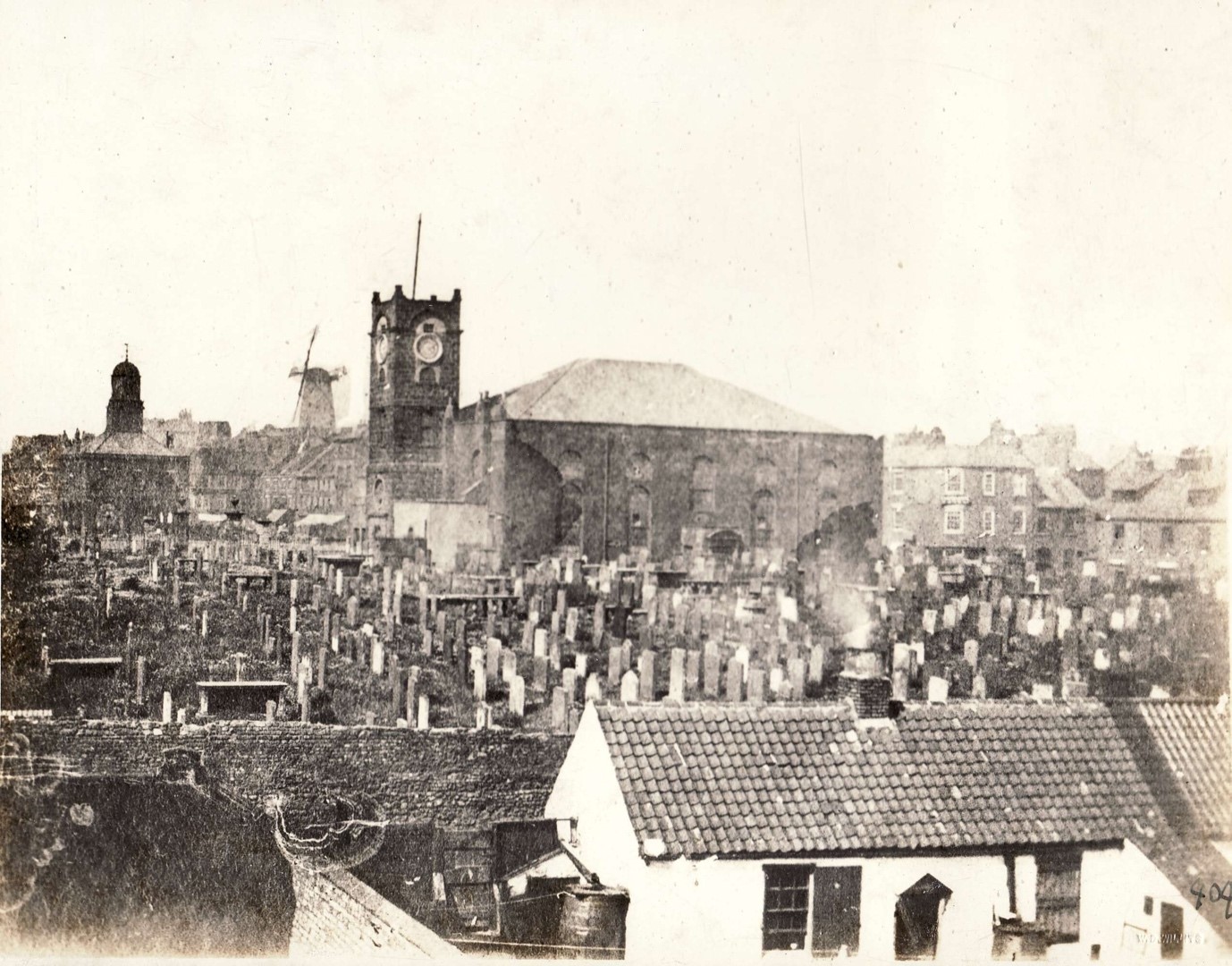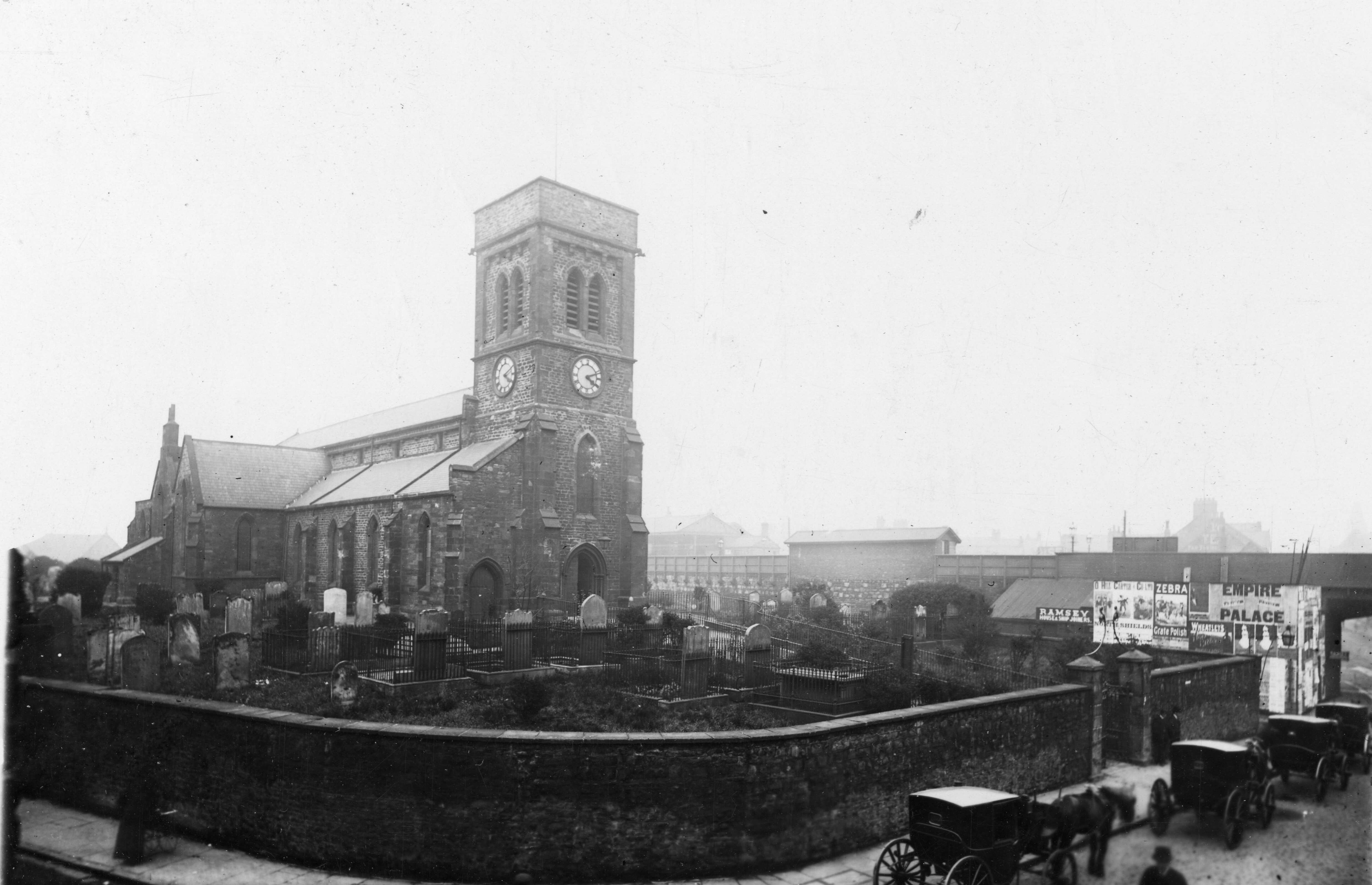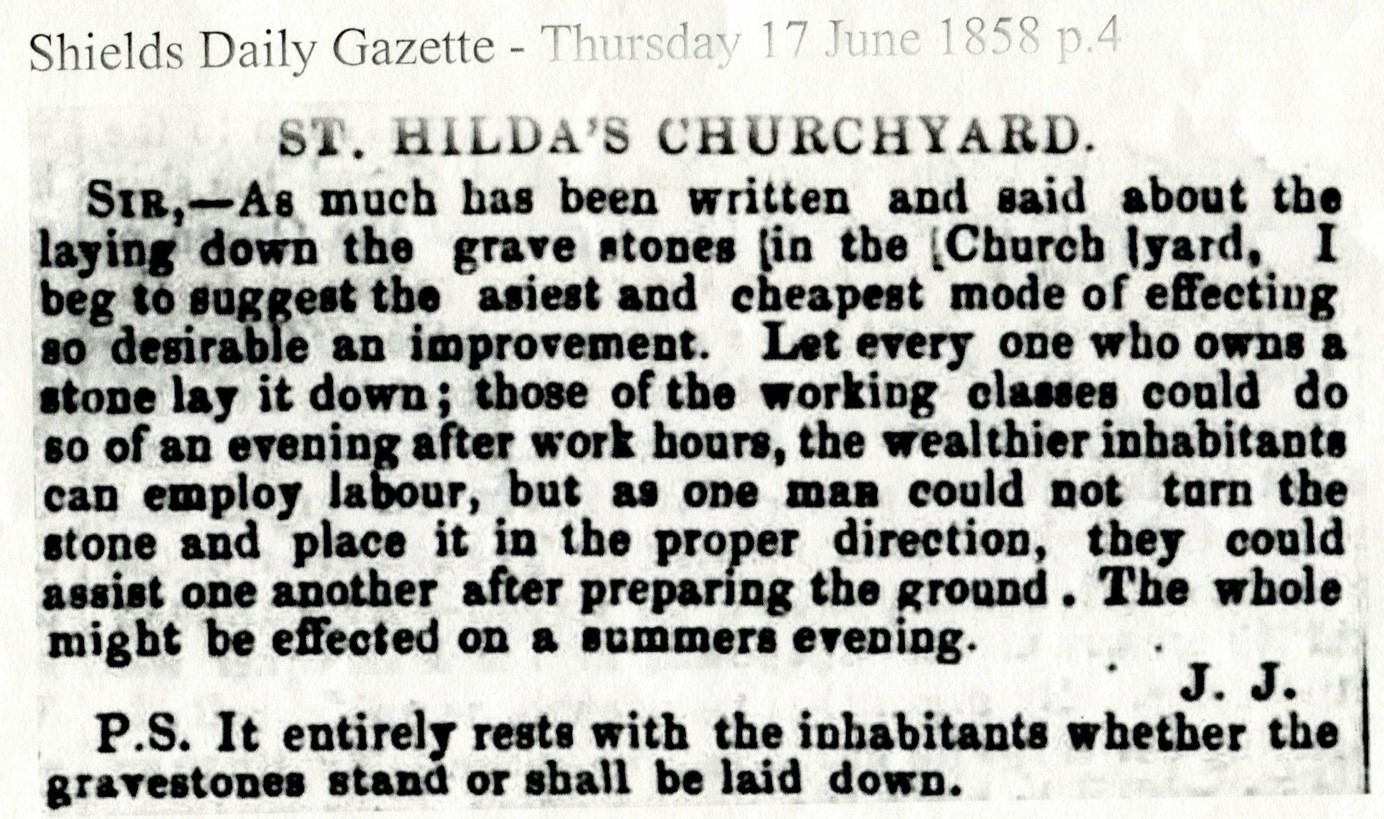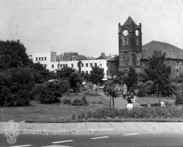
POSTS can now be found under PROJECTS.
| < PART 3 | PART 5 > |
ST HILDA'S CHURCHYARD
PART 4: The Death of St Hilda's Churchyard, South Shields

Four of Fifty One Items: Records transcribed 2009-2013
This part covers the period when it was eventually agreed to close the churchyard as well as that at Holy Trinity Church. The Burial Board had great difficulty in obtaining a site for a new cemetery. The Dean and Chapter almost the sole landowners refused to relinquish land despite the fact that the residents of South Shields and Westoe over the generations had provided greater monies than most areas in the Palatinate of Durham. Aware of the disgusting state of the churchyard, the only offer the Church Commissioners made in the provision of extra burial capacity was to extend Holy Trinity Churchyard which was in a vastly built-up area with the smell of putrefying bodies permeating the atmosphere.
It was not until November 1855 that a new burial ground was made available hence the development of Westoe Cemetery. Sixteen acres of land of the leasehold farmland of the MP Robert Ingham's Westoe estate was released together with a small strip of the leasehold of the Rev. Robert Green estate enabling access to the site.
I am including three further sources of information from more recent research. Firstly this beautiful perspective, albeit imaginative of St Hilda's Churchyard in 1770.
An Artist Looks back at St Hilda's

'Conceived & executed by Ernest Newton Esquire, 1973' (1)
�€�Mr Newton says; '' As the Old Town Hall had been built in 1768 this seemed the
obvious 'pivot' on which to base my drawing. Its actual appearance, of course, offered no problems. However, the other buildings did.
'' There is a sketch of the church taken from the old plan of Green�€™s Estate of 1760, in Hodgson �€�.and as part of the present tower dates from about then, I was able to reconstruct the church with little difficulty. ''I dated my drawing 1770, which is just before the building (1772) of the parsonage, 'an unlovely square brick building, on the north side, and at right angles to, the church tower.''
Location notes: 'South Sheelds, viewed from the South West': reading left to right, Salt Pans, River Tyne Mill Dam, Shipbuilding/repair docks, Balast Hills, Town Hall, St Hilda's Church. The churchyard borders onto the area Paradise on the banks of the River Branin with fishermen at the forefront.
Note
'Paradise' was the former home of the Green family resident in South Shields from the early 18th century; the shipbuilding area could have included the dock of James Evans (1715-1800), my direct ancestor. Salt pans were in decline from approximately two hundred in 1740 by 1770, only one hundred and forty remained; the ballast hills comprised of waste from the salt pans and chemical and glass production which were still developing with the increase in shipping from the later eighteenth and early nineteenth centuries ballast was used to ensure stability of unloaded vessels.(2)
Item 18-Date 1854-1857
20 March 1857
''And whereas by two Orders in Common of December, one thousand eight and the first of May, one thousand eight hundred and fifty five, burials were directly in St Hilda�€™s Churchyard, South Shields after the first July, one thousand eight hundred and fifty five (afterwards extended January, one thousand eight hundred and in Holy Trinity Churchyard, from and after the said first of January fit that the said orders be varied Her Majesty, by and with the ad pleased to order, and it hereby with now existing vaults and brick graves churchyards as can be opened with that has been already buried in interment of widowers, widows, children, and brothers and sisters buried therein, provided that each in charcoal and separately entombed manner.''
11 December 1854
''South Shields. In St. Hilda's Churchyard feet of the church or of any dwa only to be buried in each grave, next in any grave without a covering half foot in depth at the least upper surface of the coffin burials to be wholly discontinued after the first July, one thousand eight hundred and fifty-five''.1st May 1855
South Shields. Wholly in Holy Trinity from and after the first July, one thousand eight hundred and fifty-five and in St Stephens.Item 19
Section 18 of the Burial Act of 1855 which enabled the Corporation to give notice of the closure of St. Hilda�€™s Churchyard
''In every case in which any Order in Council has been or shall hereafter be issued from the discontinuance of burials in any Churchyard or burial ground, the burial board or churchwardens, as the case may be, shall maintain such churchyard or burial ground of any parish in decent order, and also do the necessary repair of the walls and fences thereof, and the costs and expenses shall be repaid by the overseers, upon the certificate of the burial board or churchwardens, as the case may be, out of the rate made for the relief of the poor of the parish or place in which such churchyard or burial ground is situate, unless there shall be some other fund legally chargeable with such costs and expenses.�€�
Item 20
The formation of a Burial Board and the stages in the eventual development of a municipal cemetery in South Shields 1854 to 1857
The cemetery powers of the Corporation were also never exercised. Much ridicule was excited by the fact that the cemetery site authorised by the Bill was that of the Casten Quarry of the enclosure award (now covered by Meldon Terrace, Byron, Milton and other streets). As an alternative the purchase for cemetery purposes of the Bents was proposed, the scheme also contemplating the construction of tramways connecting all parts of the town with the cemetery. While the Council was still debating the question, there occurred a serious outbreak of cholera in the borough, the first death being recorded on September 6, 1853.
Up to November 6th 44 deaths occurred from cholera in the borough, exclusive of four on shipboard, while in South Shields Union there were altogether 77 deaths. During the epidemic Dr. R. D. Grainger, the Superintendent Medical Officer of the General Board of Health (the precursor of the Local Government Board), visited the town during his inquiries into the cholera epidemic in the North, and made various recommendations to the local authorities. The cholera victims were buried near the centre of St. Hilds�€™ Churchyard in a large grave, although the General Board of Health endeavoured to enforce the burial of all victims of the disease outside of the town, and strongly recommended the provision of a cemetery, a recommendation endorsed by Doctor Grainger.
The Corporation eventually decided to provide a cemetery under the new Burials Act, and to transfer its control to a specially elected body. At the township meeting on March 31, 1854, a Burial Board of nine members for each township was elected, the first members being:-
SOUTH SHIELDS:- Rev. James Carr, Messrs. John Toshach, George Potts, William James, J. W. Lamb, Thomas Moffett, J. Carnaby, R. B. Ridley, and E. T. Wawn. WESTOE:- John Robinson (the Mayor), R. J. J. Mays, W. Anderson (Bents House), Matthew Stainton, John Armstrong, Tony Waller, F. Corder, J. C. Stevenson, and George Hudson.
The Burial Board encountered great difficulty in obtaining a site for a cemetery, owing to the opposition of the Dean and Chapter (practically the sole landowners). It was not until November 1855 that they obtained 16 acres of land of the leasehold of Robert Ingham, with a small strip of the leasehold of the Rev. R. Green as an approach thereto. The site of the cemetery, about midway between Westoe Lane and the sea, is described in the Home Secretary�€™s letter approving the purchase as �€˜half a mile south-east of the town!
The first internment took place on October 30, 1856, while the Church of England portion was consecrated by the Bishop of Durham on April 24, 1857. Meantime the Corporation had taken action to have the old churchyards closed, a memorial to the Home Secretary to that effect being unanimously adopted on July 5, 1854.

Item 21
Collation of information from 1854-1856 leading to the closure of the Churchyard
Sepulchre at South Shields Trinity Churchyard A few weeks after the meetings previously referred to some public feeling was aroused by the proposal of the Dean and Chapter of Durham to enlarge Holy Trinity Church burial ground. The Shields Gazette, on November 24th 1854, speaking about this matter ---- ''It will be in the recollection of our readers and the public at large, that about six months ago we had occasion to remark in rather severe terms upon the proceedings of the Re. Thomas Dixon, Incumbent of Trinity district, when he endeavoured to persuade the Select Vestry to assist him and the Dean and Chapter in the enlargement of the burial ground, which the vestry was properly declined to do so. We had thought that no more would have been heard of the matter, especially as the ratepayers of Westoe and South Shields townships had agreed to join and establish a cemetery for the general well-being of the borough. But, no; such unfortunately seems not to be the case.
The Dean and Chapter at whose instigation we know not through their agent, we understand, are now busily enclosing the ground for the very purpose we so strenuously opposed. The consequence will be, that in the course of a few weeks, unless active measures be immediately taken by the authorities of the town (by the Town Improvement and Public Health Committee of the Corporation-it is their duty we think) an evil worse than that at St Hilda�€™s will soon be inflicted upon the town; from one end nearly to the other the of Commercial Road will be the deposit of the dead, in a densely-populated district already the focus of the cholera, whenever it bursts out in our locality----and in its midst Trinity School is situated where from 350 to 400 of the young children of the labouring population are to be daily surrounded by the pestilential exhalation constantly emitted therefrom. What, may we ask, is the utility of sanitary improvements in such manifest obstructions to be thrown in the way by the Dean and Chapter of Durham?
We trust that instant application will be made to the Secretary of the Home Department, to send down Dr Sutherland to investigate into the matter, and if possible, prevent this outrage upon the feelings and contempt for this important district of South Shields containing upwards of 14,000 residents. The present over-crowded condition of the burial ground, and the fact that attempting against the wishes of the parishioners to enlarge it, are convincing reasons to prove the absolute necessity of closing it altogether, along with that of St Hilda�€™s and we sincerely hope that the result of Lord Palmerstone�€™s interference will be to order immediately, the same course to be adopted by Trinity Church as he has directed to be done at St Hilda�€™s, namely, that all interments for the future shall be according to certain fixed regulations, and to cease altogether by 1855.�€™�€™
A Cemetery Site Unpurchasable
On Wednesday, April 6th, 1855, the Town Council, on the motion of Mr Glover, decided to petition Parliament to alter and amend the Public Health Act, so as to make it compulsory on owners of land to sell to parishes or corporations such portions as may be needed for sepulchre. In support of the motion he said they had had a burial board in existence nearly nine months, and he was sorry to say they could not report progress. It appeared to be a most difficult thing to get any land in the neighbourhood, whether it was from parties being unwilling to sell the land, or wanting to high a price for it he could not ---Dean and Chapter Castigated
In an editorial April 13th, 1855, the Gazette says: ''It seems a very deplorable piece of business that no land is to be had in South Shields, either for a cemetery or a cricket ground. Both the Burial Board and the batsmen are bowled out for want of a bit of land. No room for the recreation of the living; no descent spot of earth wherein to lay the dead. For this is a �€˜church leasehold�€™ town. Under the genial and generous sway of the Durham ecclesiastics, the inhabitants of South Shields are, living, shut altogether out of a cricket ground, and, dying, are crammed into a grave ground than which, we will be bound to say, none more crowded and unwholesome----none more revolting either to the eye or to the moral sense----none more degrading to the living or more desecrating to the dead, exists throughout the civilised world.When one considers how this enormously valuable estate of the Dean and Chapter (South Shields and Jarrow), has grown up through the labour of the inhabitants without a single stroke of the arm or thought of the brain---- (except one of extortion) ----from the drones to whom it belongs, one would expect to hear a long list of benefactions conferred on the inhabitants by the beneficiaries. Handsome gifts of public recreation grounds----cemeteries presented (ready consecrated) for nothing; ----and acres of cliff to make piers for sheltering the bodies of those under pretence of caring for whose souls Deans and Chapters take such heavy toll. If any one asks where are those gifts; Echo with unusual energy and emphasis, will answer �€˜ the Dean.�€™
Of the millions of money drawn by the ecclesiastics of Durham from this corner of the county, how many thousands have been bestowed back for any purpose of good to the inhabitants? Reaping where they have not sowed, gathering where they have not strawed, these usurious priests have proceeded until now, that their reign is, under its present form, drawing to a close; the natural result of which system is----not that its victims have the opportunity of enfranchising themselves and their property,----instead of exerting themselves to purchase their freedom, they are hiding their talent in the earth, and waiting the coming of the Church Commissioners to take away the little they possess. It is but a distorted application of the parable, we confess, but how is it possible to offer any correct illustration of scripture by the conduct of the Dean and Chapter of Durham? May the leaseholders no longer offer a correct illustration of the unprovident servant who hid his talent in the earth, and was justly punished by having it taken away.�€�
Sepulchre at South Shields: An Extension of Time
At a meeting of the Town Council, held on June, 6th 1855, Mr Glover said that he learned that the South Shields Burial Board had made an application to the Home Secretary for, and obtained an extension of, time for keeping St Hilda�€™s Churchyard open until the 1st October. After remarking on the want of courtesy displayed by the Board to the Council, and pointing out the danger to public health that was likely to arise from further burials at St Hilda�€™s, he moved that the application be opposed in the proper quarter. Mr Hutchinson seconded the resolution, in doing which he gave some facts relative to the local burial placesHe stated that the official report showed there had been 803 burials in the preceding year, out of a population of 30,000. St Hilda�€™s Churchyard contained 2 acres 1 rood, and had been used as a burial place since the fourteenth century. In the year 1816 it was covered with ballast to a depth of about 5 feet. The two acres included the site of the church. Trinity Churchyard contained little more than one acre, and had been used as a burying ground about twenty years, and was almost wholly filled; the space mentioned including the church site and the schools. St Stephen�€™s Churchyard contained about three acres; about one fifteenth part was occupied, and that not wholly. The three acres contained the church site only. The churchyard had been opened five years before, and there had been 532 interments.
BURIAL BOARD WERE IN A DILEMMA
Mr Carnaby, another member of the Council, said the as to where to bury the dead. Were they to lie in the street? The Town Clerk, as secretary of the Burial Board, stated that they had used every endeavour to procure ground for a cemetery, but could not succeed. High prices had been asked for the ground, of leasehold tenure, which they, having the interests of the ratepayers at heart, declined to give. After further discussion, it was resolved that the facts of the case, in reference to St Hilda�€™s Churchyard, be represented in a memorial, with a view to it being finally closed in July.COULD NOT BE RESCINDED
At the following meeting of the Council a communication from Sir George Grey, dated Whitehall, June 25th, 1855, was read, acknowledging receipt of the petition, and informing the Council that the time for closing St Hilda and Trinity Churchyards was extended from the 1st July to the 1st October next, in consequence of a representation made by the Burial Board of the difficulty which they experienced in obtaining suitable ground for a new burial ground, and the consequent impossibility of the necessary preparation being made before the 1st July; and the extension could now be rescinded.THE CHURCHYARD CLOSED
The churchyard was closed on the 1st January 1856, no further interments being allowed to take place. In a short editorial on January 17th, the Shields Gazette says:- ''The churchyards of London are closed, and the officer of health rejoices. St Hilda�€™s graveyard is also closed at last, and every friend of decency and health in the borough may well rejoice. We trust something will be done to alter the disgusting appearance of St Hilda�€™s churchyard; to give it a descent covering of green grass, and to ornament it with a few shrubs. Unless some public authority (the Town Council would be the best) can secure the old churchyards from desecration, we fear they will all, within a century or two, be converted into markets or building sites. There have been many instances of this kind of desecration and if the public trusts to the Bishop�€™s �€˜consecration�€™ of the ground, the public will be very weak indeed. All these old churchyards should remain as little parks, or breathing spaces in the heart of towns and the only way to secure them is to have them, by enactment of the legislature, place under the guardianship of the public authorities.�€�LAND AT LAST
The Burial Board eventually overcame all obstacles in the way of securing a site for interments, for in this same month we read that the proposed site for the burial ground for the united townships of South Shields and Westoe had been inspected by Dr Holland, an inspector under the Burial Acts, sent down by Sir George Grey, the Home Secretary, for that purpose. Then in an issue a few weeks later appears the following ---- ''We are glad to hear that Mr Salmon, as clerk to South Shields and Westoe Burial Board, has received an answer to his application, conveying the approval of the Home Secretary, and the order of Her Majesty in Council, made in pursuance thereof, of the 16 acres of ground (part of Mr Ingham�€™s farm) selected by the Burial Board for a cemetery. The ground is most conveniently situated, between Ogle Terrace and the village of Westoe, is part of the field lying west of Bent House, and will have a wide and convenient approach from the turnpike. There are now no obstacles to an immediate forward movement, there being every determination on the part of the Burial Board to proceed with promptitude and vigour in getting the new burial ground ready for interments therein.ANOTHER CLOSURE
The possession of compulsory powers for the closing of grave grounds, without having similar ones for their replacement, places difficulties in the way of burial boards, and renders their proceedings slower than they would otherwise be. The application of the Burial Board, as made by their clerk, for an extension on the 1st of July next, of the time for the closing of Trinity churchyard (which was inspected by Dr Holland, during his official visit to South Shields), has also been successful, so that the 13,000 inhabitants of Trinity district will no longer be subjected to the expense and inconvenience of conveying their dead to so distant a churchyard as St Stephen�€™s.�€�ST. HILDA�€™S CHURCHYARD
The Churchyards of London are closed, and the officer of health rejoices, St. Hilda�€™s grave-yard is also closed last, and every friend of decency and health in the borough may well rejoice. We trust something will be done to alter the disgusting appearance St. Hilda's churchyard; give it decent covering of green grass, and to ornament it with a few shrubs. Unless some public authority, (the Town Councils would be the best), can secure the old churchyards from desecration, we fear they will all, within a century or two, be converted into markets or building sites. Then, have been many instances this kind of desecration and if the public trusts to the Bishop's consecration of the ground, the public will be very weak indeed. All these old churchyards should remain as little parks, or breathing spaces in the heart of towns, and the only way to secure them to have them, by enactment of the legislature, placed under the guardianship of the public authorities.North & South Shields Gazette and Northumberland and Durham Advertiser - Thursday 17 January 1856
Note
Yet twenty-nine months later, the churchyard with restricted burials, was suffering from neglect with this appeal for the residents of the town, of all classes to act to avoid further deterioration of the site.


The Churhyard with landscaped gardens developed in the 1960s.
REFERENCES
1 An artist looks back at St. Hilda�€™s Shields Gazette, Saturday, June 9th 1973
2 Ref. Joe Orton: South Shields Local History Website 2023
3 & 5 Items 18 & 20-National Archives, Kew, London, Reference: - B. I8054:Dates: 11th December 1854; 1st May 1855; 30th January 185?; 24th June 185?; 20th March 1857. Record of the stages in the closure of St. Hilda�€™s Churchyard for burials
6 Item 19-Durham County Record Office: Date: 1855 Reference, EP/SS.SH 4/652-Section 18 of the Burial Act of 1855 which enabled the Corporation to give notice of the closure of St. Hilda�€™s Churchyard
Item 20-South Tyneside Public Library-(1996) Extract from The Borough of South Shields by George B. Hodgson published in 1903 page 193 (ISBN 0 906617251): Dates: 1854 to 1857
The formation of a Burial Board and the stages in the eventual development of a municipal cemetery in South Shields
7 Item 21-Durham County Record Office, Date: 1855. Reference: EP/SS.SH 4/652Section 18 of the Burial Act of 1855 which enabled the Corporation to give notice of the closure of St. Hilda�€™s Churchyard
8 Shields Daily Gazette - Thursday 17 June 1858 p.4
9-South Tyneside Libraries